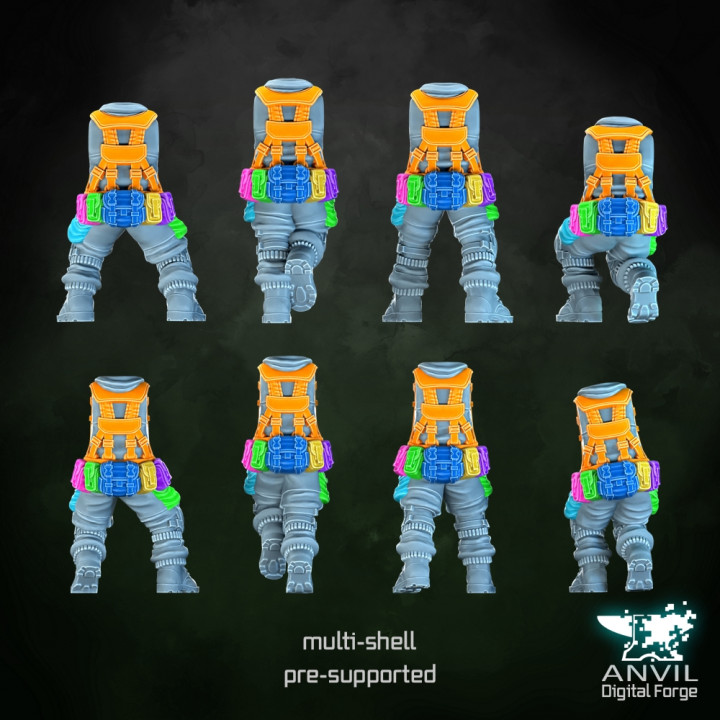In our Miniature Review series, we look at the wide world of tiny soldiers for cool stuff to share with all of you. This week, Mike takes a look at Anvil Digital Forge after a year of subscription to their Patreon.
Who are Anvil Industry? You might already be familiar with Anvil Industry from their Regiments range of conversion pieces and alternative sculpts covering a huge array of themes and settings. I’ve used them myself in the past, but it isn’t what we’re focusing on in this article. With the proliferation of consumer grade resin printing, Anvil entered the arena with Anvil Industry Digital Forge. Available via their website, Patreon, and MyMiniFactory there are plenty of options if you’re looking to check out what’s available.
But why are they interesting? Patreon and other subscription based services are awash with various creators offering monthly packs of 3D printable minis, bits, terrain and anything else you could think of for tabletop gaming. What sets Anvil Industry apart is their large variety of modern and sci-fi sculpts, taking inspiration from media such as Fallout, Star Wars, The Last of Us and Stargate SG-1. Everything is provided pre-supported and without supports and the printing experience for the majority of models is excellent. The one issue I hit, and it’s something I should’ve seen coming and mitigated myself, was with a model from the welcome pack. The pile of crates presents a large and flat surface to the print bed and with my print settings I ended up with some rounding and delamination. Ideally this model should be fully hollow with a 2mm shell, which is something they’ve done for other scatter terrain pieces in the set and is simple enough to do yourself. Pre-supported models also scale down pretty well. For a recent project I wanted a gunner for my Gaslands War-Rig and with a bit of guess work managed to get a reasonably sized machine gunner printed, scaling the model down by around 60%. Much like their physical offerings, all of the model pieces can be mixed and matched, with separate arms, legs torsos, heads, weapons, and other accessories. Physical kit-bashing is incredibly easy and this shouldn’t really come as a surprise, given their background. That isn’t what makes them unique in the digital STL subscription game though.
Multi-Shell Models
The thing that makes Anvil unique in their approach and truly sets them apart in this area is providing multi-shell STL files with clear and extensive tutorials on how to make the most of them. Providing multi-shell models makes kit-bashing and customisation before printing even easier. Using an application like Meshmixer or Blender, pieces of the models can be removed, new pieces can be imported, and the whole thing can then be exported for printing. On their larger projects, models are offered with Blender rigging for easy custom poses. If you’re not a fan of a given loadout, it’s simple to turn off that shell and with each monthly release shells are colour coded in preview images making it even easier to see what can be changed.

Getting ready for the next year, I wanted to run some Zona Alfa demo games. Anvil have released a number of solid options for the this over the past year and between the Welcome Pack, two Post-Apocalypse Packs and Undercover Operators I had a lot of great choices. Zona Alfa draws a lot of inspiration from the STALKER setting, and this Soviet styled team fits perfectly. Competing against them for the riches in The Zone is a team of Western themed operatives.
From a demo perspective, I’m aiming to support up to eight players with a few options so I wanted at least ten models total. With my NATO team missing two operatives. I wanted to add a long range support character and another mid-range or assault character. Playing around with my available options, I settled on adding a Paracord-wrapped silencer from the Welcome Pack to the MRAD from the Undercover Operatives pack, and a hydration pack converted to a small backpack.
Creating the silenced MRAD was a straight forward job, aligning the faces of the two pieces and then merging them together before exporting them ready to be printed. With the way the separate weapons are oriented, no additional supports were needed. For the backpack, I simply exported without supports and added my own in Lychee.

Conclusion
Anvil offer a lot of great options for conversion pieces and various skirmish games. Even if every monthly release doesn’t grab you at the time, long term supporters get access to larger rewards on a three monthly basis. The level of customisation and the documentation they’ve produced to support this makes their monthly Patreon a solid value proposition. If you don’t own a resin 3D printer, you can still order pick-up items from their Digital Forge print-on-demand service based in the UK.
If you’d like to subscribe to Anvil Digital Forge you can find their Patreon here. Their main store page, including Print-On-Demand services, can be found here.








You must be logged in to post a comment.